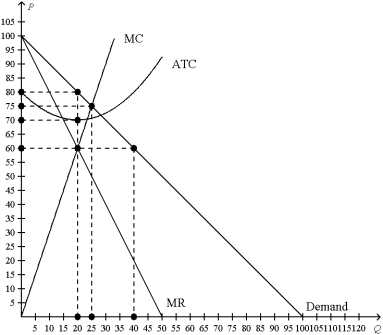A) oligopoly
B) monopoly
C) monopolistic competition
D) cartels
F) C) and D)
Correct Answer

verified
Correct Answer
verified
Multiple Choice
A profit-maximizing firm operating in a monopolistically competitive market that is in a long-run equilibrium has
A) minimized average total cost.
B) chosen to produce where demand is unitary elastic.
C) produced the efficient scale of output.
D) chosen a quantity of output where average revenue equals average total cost.
F) A) and B)
Correct Answer

verified
Correct Answer
verified
Multiple Choice
To maximize its profit,a monopolistically competitive firm
A) takes the price as given and chooses its quantity,just as a competitive firm does.
B) takes the price as given and chooses its quantity,just as a colluding oligopolist does.
C) chooses its quantity and price,just as a competitive firm does.
D) chooses its quantity and price,just as a monopoly does.
F) B) and D)
Correct Answer

verified
Correct Answer
verified
Multiple Choice
Which of the following statements is correct?
A) In the long run,both perfectly competitive firms and monopolistically competitive firms operate with excess capacity.
B) A firm operates with excess capacity when,in the long run,its level of output is below the efficient scale.
C) For any firm,efficient scale is the level of output at which the average-total-cost curve is tangent to the demand curve.
D) All of the above are correct.
F) A) and D)
Correct Answer

verified
Correct Answer
verified
Multiple Choice
Critics of advertising argue that in some markets advertising may
A) attract products of lower quality into the market.
B) attract less informed buyers into the market.
C) decrease elasticity of demand allowing firms to charge a larger markup over marginal cost.
D) enhance competition in markets to an unnecessary degree.
F) None of the above
Correct Answer

verified
Correct Answer
verified
True/False
In a monopolistically competitive market,the number of firms adjusts until economic profits are driven to zero.
B) False
Correct Answer

verified
Correct Answer
verified
True/False
In the long run,monopolistically competitive firms produce where demand equals marginal cost.
B) False
Correct Answer

verified
Correct Answer
verified
Multiple Choice
Which of the following markets impose deadweight losses on society?

A) (i) and (ii) only
B) (ii) and (iii) only
C) (i) and (iii) only
D) (i) only
F) A) and B)
Correct Answer

verified
B
Correct Answer
verified
Multiple Choice
Monopolistic competition differs from perfect competition because in monopolistically competitive markets
A) there are barriers to entry.
B) all firms can eventually earn economic profits.
C) each of the sellers offers a somewhat different product.
D) strategic interactions between firms are important.
F) C) and D)
Correct Answer

verified
Correct Answer
verified
Multiple Choice
Which of the following statements is not correct?
A) Monopolistic competition is similar to monopoly because in each market structure the firm can charge a price above marginal costs.
B) Monopolistic competition is similar to perfect competition because both market structures are characterized by free entry.
C) Monopolistic competition is similar to oligopoly because both market structures are characterized by barriers to entry.
D) Monopolistic competition is similar to perfect competition because both market structures are characterized by many sellers.
F) None of the above
Correct Answer

verified
Correct Answer
verified
Multiple Choice
Consider monopoly,monopolistic competition,and perfect competition.In which of these three market structures does a profit-maximizing firm charge a price that exceeds marginal cost?
A) monopoly only
B) monopoly and monopolistic competition only
C) monopoly,monopolistic competition,and perfect competition
D) The answer cannot be determined without knowing whether the market is in the long run or short run.
F) All of the above
Correct Answer

verified
B
Correct Answer
verified
True/False
Economists are unanimous in their belief that advertising is socially inefficient.
B) False
Correct Answer

verified
Correct Answer
verified
Multiple Choice
The deadweight loss that is associated with a monopolistically competitive market is a result of
A) price falling short of marginal cost in order to increase market share.
B) price exceeding marginal cost.
C) the firm operating in a regulated industry.
D) excessive advertising costs.
F) All of the above
Correct Answer

verified
Correct Answer
verified
Multiple Choice
The free entry and exit of firms in a monopolistically competitive market guarantees that
A) both economic profits and economic losses can persist in the long run.
B) both economic profits and economic losses disappear in the long run.
C) economic profits,but not economic losses,can persist in the long run.
D) economic losses,but not economic profits,can persist in the long run.
F) None of the above
Correct Answer

verified
Correct Answer
verified
Multiple Choice
The fact that monopolistically competitive firms charge a price that exceeds marginal cost is responsible for the
A) business-stealing externality that is observed in monopolistically competitive markets.
B) product-variety externality that is observed in monopolistically competitive markets.
C) inefficiencies of the long-term losses earned by monopolistically competitive firms..
D) persistence of positive profits into the long run for monopolistically competitive firms.
F) B) and C)
Correct Answer

verified
Correct Answer
verified
Multiple Choice
Table 16-5
Traci's Hairstyling is one salon among many in the market for hairstyling.The following table presents cost and revenue data for hair cuts at Traci's Hairstyling.
 -Refer to Table 16-5.Given the cost and revenue data,Traci's is
-Refer to Table 16-5.Given the cost and revenue data,Traci's is
A) not in a long-run equilibrium.More businesses will enter the hair salon market in the long-run.
B) not in a short-run equilibrium.
C) not in a long-run equilibrium.Some businesses currently in the hair salon market will exit the market in the long-run.
D) in a long-run equilibrium.
F) A) and C)
Correct Answer

verified
Correct Answer
verified
Multiple Choice
In both perfect competition and monopolistic competition,each firm
A) has some monopoly power.
B) sells a product that is at least slightly different from those of other firms.
C) faces a downward-sloping demand curve.
D) has many competitors.
F) A) and C)
Correct Answer

verified
Correct Answer
verified
Multiple Choice
Monopolistic competition is characterized by which of the following attributes?

A) (i) and (iii) only
B) (i) and (ii) only
C) (ii) and (iii) only
D) (i) ,(ii) ,and (iii)
F) All of the above
Correct Answer

verified
D
Correct Answer
verified
Multiple Choice
A firm in a monopolistically competitive market faces a
A) downward-sloping demand curve because the firm's product is different from those offered by other firms.
B) downward-sloping demand curve because there are only a few firms in the market.
C) horizontal demand curve because there are many firms in the market.
D) horizontal demand curve because firms can enter the market without restriction.
F) C) and D)
Correct Answer

verified
Correct Answer
verified
Multiple Choice
Figure 16-2
This figure depicts a situation in a monopolistically competitive market.  -Refer to Figure 16-2.How much consumer surplus will be derived from the purchase of this product at the monopolistically competitive price?
-Refer to Figure 16-2.How much consumer surplus will be derived from the purchase of this product at the monopolistically competitive price?
A) $200
B) $312.50
C) $400
D) $800
F) A) and C)
Correct Answer

verified
Correct Answer
verified
Showing 1 - 20 of 416
Related Exams